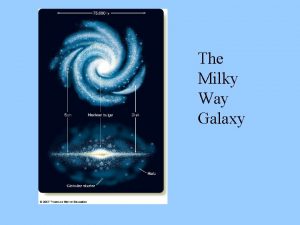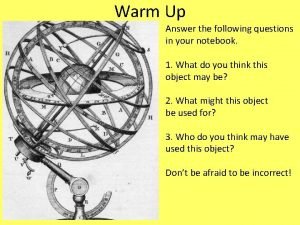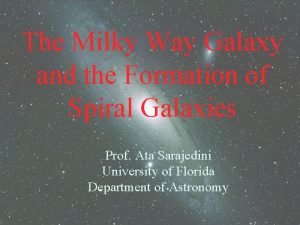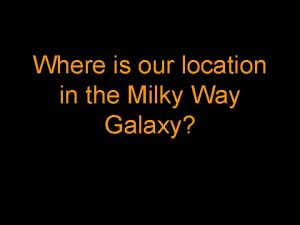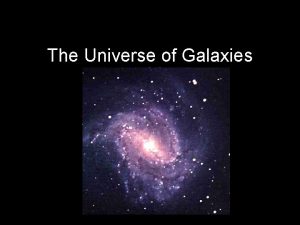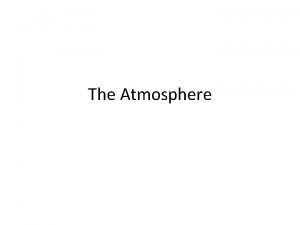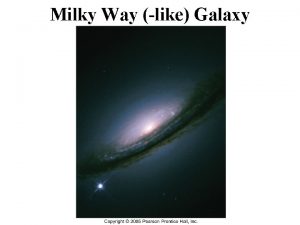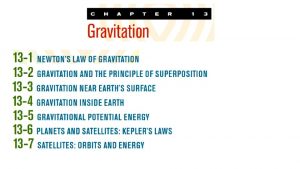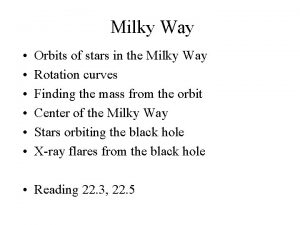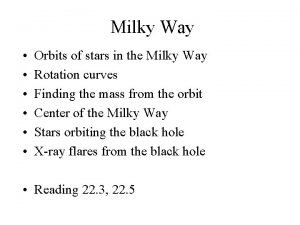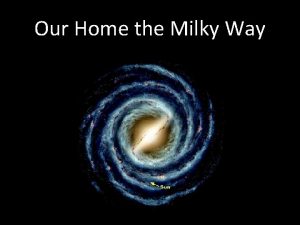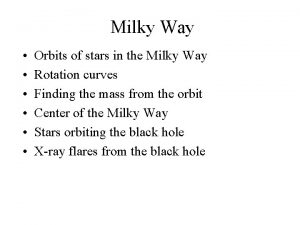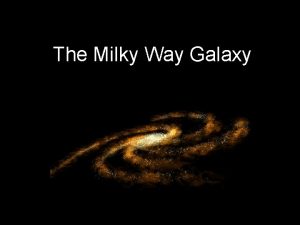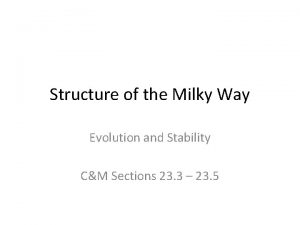The Structure of the Milky Way What is















- Slides: 15

The Structure of the Milky Way What is the size and shape Of the system of stars in which We live?

Outline of lecture • • Lecture taken from Chapter 22 Skip material on interstellar gas Skip historical stuff Begin with properties of globular star clusters (crucial for mapping out the galaxy).

Globular clusters and why they are important in this context • Big balls of about 100, 000 stars • You can see them at great distances • About 150 cataloged • They are unevenly distributed in the sky (great summertime objects, few in the winter). (Figure 22. 25) 1/5 of globular clusters In 2% of the sky

Distribution of globular clusters on the sky implies a distribution in space like Figure 22. 26

Where (on the sky) is the galactic center? In Sagittarius RA = 17 h 45 m DEC=-28. 3 degrees Position on SC 1 Chart

You can’t determine the distances to globular clusters by parallax. They are too far away (think of theodolite lab). You need another method. If you know the absolute magnitude M of an object and can measure the apparent magnitude m, you know the distance. The distance modulus (m-M) is a direct measure of the distance.

Object of choice: Cepheid Variables (after Delta Cephei) • Cepheid variables vary in brightness periodically • Periods range from a couple of days to 100 days. • Absolute magnitude dependent on period

Distances to globular clusters and the galactic center • • 1 parsec = 3. 26 light years Need bigger “yardsticks” for these objects 1000 parsecs=1 kiloparsec=3260 light years Distance to galactic center = 8. 5 +/- 0. 50 kiloparsecs

How far is 8. 5 kiloparsecs? • Let 1 au = 1 cm • Nearest star (1. 3 parsecs) = 2. 68 km = 1. 66 miles • 8. 5 kiloparsecs = 17, 532 km = 10, 870 miles (2. 74 Earth radii) • Light signal transmitted from the GC would take 27, 700 years to reach us

A view of the galactic center (visible only at radio wavelengths)

New Coordinates: galactic coordinates • “imaginary lines on the sky” • A line through the middle of the Milky Way = galactic equator • 0 degrees galactic longitude in direction of the galactic center • Coordinates are galactic latitude and longitude

Galactic coordinates

Observations indicate the shape and size of the Milky Way Galaxy

Structure of the Milky Way • • Disk Bulge Galactic center Galactic halo Question: what simple observation Is consistent with a part of this picture

A view of the Milky Way with an artist’s touch
 Milky way description
Milky way description Where is the solar system located in the milky way
Where is the solar system located in the milky way Democritus milky way
Democritus milky way Science olympiad solar system
Science olympiad solar system Canis major overdensity
Canis major overdensity Dung beetle milky way
Dung beetle milky way What is the name
What is the name The milky way
The milky way Milky way galaxy sketch
Milky way galaxy sketch My fonterra milky way
My fonterra milky way Milky way galaxy shape
Milky way galaxy shape Glowing splint
Glowing splint Pr��ce v cestovn�� kancel����i praha
Pr��ce v cestovn�� kancel����i praha Milky ribbon worm
Milky ribbon worm Milky appearance of plasma
Milky appearance of plasma How to do a two way frequency table
How to do a two way frequency table
